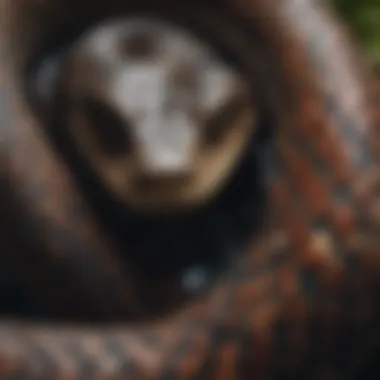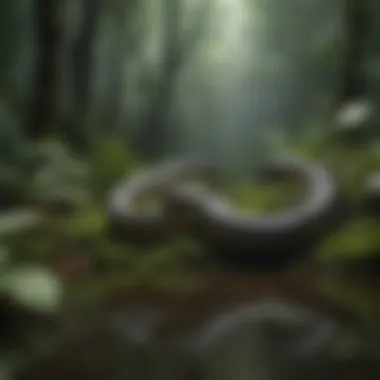Exploring the Amazon Sink Snake: Habitat and Conservation


Intro
The Amazon sink snake is a fascinating creature, yet it is often overlooked in discussions about biodiversity. This species has adapted to thrive in the diverse ecosystems of the Amazon rainforest. Understanding its habitat, biological traits, and the role it plays in its ecosystem is crucial.
As environmental changes continue to challenge wildlife, the Amazon sink snake faces both threats and opportunities. Conservation efforts become meaningful when one knows about the intricacies of such species. The importance of researching and advocating for the Amazon sink snake cannot be understated. This article explores many layers of this unique snake, shedding light on its daily life, ecological importance, and the urgent need for protective measures.
Prologue to the Amazon Sink Snake
The Amazon sink snake deserves special attention within the biological landscape of the Amazon rainforest. Understanding its characteristics, ecology, and conservation status is vital. This species serves as an indicator of ecosystem health, reflecting the impacts of environmental changes. The Amazon sink snake plays a crucial role in maintaining ecological balance while also being a fascinating subject of study for herpetologists and nature enthusiasts alike.
Defining the Species
The Amazon sink snake, known scientifically as Pseudoboa neuwiedi, belongs to the subfamily Dipsadinae. These snakes are non-venomous and are typically medium-sized, with adults averaging between one to two meters in length. Their morphology is quite distinctive, with a slender body and a pointed snout, adapted for their unique habitat. Unlike more notorious serpents, this species relies on a more subtle approach to its environment, often going unnoticed.
Their diet primarily consists of small mammals and amphibians, which they capture using constriction techniques. As a non-venomous species, they showcase a range of behavioral adaptations that support their success in varied environments. These include nocturnal foraging habits and the ability to blend into their surroundings.
Geographical Distribution
The geographical distribution of the Amazon sink snake is primarily within the tropical regions of South America. This includes countries such as Brazil, Peru, and Colombia. The species typically inhabits forested areas, including both primary and secondary forests, as well as regions nearby rivers and swamps. The moist climate and rich biodiversity of these habitats provide ideal conditions for the Amazon sink snake.
Distribution patterns show a preference for areas where prey is abundant. As such, they are often found in regions with dense vegetation, which offers both food sources and camouflage from predators. The ongoing deforestation and habitat degradation in these areas pose significant threats to their survival, which makes understanding their distribution critically important for conservation efforts.
"The Amazon sink snake is a keystone species in its ecosystem, indicating the health of its environment."
As urban expansion and agricultural practices encroach upon natural habitats, the delicate balance that sustains the Amazon sink snake and other wildlife faces challenges. Awareness of their geographical spread aids in targeted conservation initiatives, thus helping protect this lesser-known species.
Physical Characteristics
Understanding the physical characteristics of the Amazon sink snake is crucial for several reasons. These traits not only define the species but also influence its behavior, habitat preferences, and interactions within the ecosystem. By examining size, morphology, coloration, and patterns, we can gain insight into the snake's adaptation and ecological role. This understanding further informs conservation efforts, helping to mitigate threats to the species and sustain its habitat.
Size and Morphology
The Amazon sink snake varies in size, typically reaching lengths of about 1 to 1.5 meters. Its elongated body shape is typical of many snake species, offering several advantages such as mobility in water and among dense vegetation. The morphology also includes a distinct head that is slightly broader than the neck, allowing for easier navigation through its aquatic environment. This unique structure aids in its primary mode of hunting, which involves quickly striking at prey hiding beneath the water's surface.
Additionally, the snake exhibits a robust build that helps it in both swimming and maneuvering through its terrestrial habitat. Its muscular composition enables quick and agile movements, critical for both evasion from predators and capturing prey. Understanding these measurements is not just of academic interest; it also assists conservationists in identifying healthy populations of the species based on size distribution within habitats.
Coloration and Patterns
The coloration of the Amazon sink snake is an essential adaptation mechanism. These snakes typically display shades of brown, green, and black, with a pattern that enhances their ability to blend into the varied environments of the Amazon rainforest.
This cryptic coloration is vital for camouflage, concealing the snake from both predators and prey. The patterns can include stripes or spots, which help disrupt the outline of the snake's body, making it less recognizable in the dappled light of its habitat. This blending behavior plays a significant role in its predatory strategies.
In addition to aiding in hunting, the coloration also participates in social signaling. For instance, during mating seasons, brighter patterns may become more pronounced to attract potential mates. This interplay demonstrates the importance of understanding coloration as both a protective and communicative tool for the Amazon sink snake.


"The distinctive camouflage patterns of the Amazon sink snake illustrate the intricate relations between morphology and ecological adaptation."
Behavioral Patterns
Understanding the behavioral patterns of the Amazon sink snake is crucial for comprehending its role in the ecosystem. These behaviors influence not only its survival but also the delicate balance within its habitat. Observing how these snakes interact with their environment can reveal vital insights into their adaptations and the challenges they face.
Habitat Preferences
The Amazon sink snake thrives in specific environments. It favors wetlands, particularly those found in the Amazon rainforest. This habitat provides ample opportunities for hunting and breeding. The dense foliage and water bodies offer protection from predators and allow for a diverse diet.
These snakes often hide in vegetation near water, using the camouflage of their coloration to blend in. They tend to be most active during the cooler hours of the day or just after rainfall, when prey is more likely to be present. The choice of habitat influences their population dynamics, as well as the overall health of the ecosystem.
Feeding and Hunting Techniques
Feeding habits of the Amazon sink snake are fascinating. As a carnivorous species, it mainly preys on small fish, amphibians, and sometimes rodents. Their hunting techniques are efficient and adapted to their environment.
The snakes use a method called ambush predation, which involves staying still for long periods. When prey approaches, they strike quickly. This strategy minimizes energy expenditure while maximizing their chances of a successful catch. Their ability to camouflage in their surroundings plays a critical role in this technique. The Amazon sink snake's role as a predator helps to regulate populations of other species, thereby maintaining ecological balance.
Mating Rituals
Reproduction in Amazon sink snakes is marked by interesting mating rituals. During the breeding season, males display courtship behaviors, which can include aggressive movements and body posturing. These actions are designed to attract females and establish dominance.
Once a female accepts a male, copulation occurs. This process is typically brief, and fertilization is internal, resulting in live births. The timing of these rituals often coincides with environmental cues, such as rainfall or temperature changes, making it crucial for successful reproduction.
Understanding these mating patterns is essential, as it highlights the reproductive health of the species. Declines in population can often be traced back to disruptions in their breeding behaviors, further emphasizing the significance of preserving their natural habitats.
"Behavioral patterns provide critical insights into the Amazon sink snake's adaptability, survival, and ecological significance."
In summary, the behavioral patterns of the Amazon sink snake are intricately linked with its biological success and ecological importance. Their habitat preferences dictate their feeding strategies and breeding habits, all of which are essential for sustaining their populations and the ecosystems they inhabit.
Ecological Role of the Amazon Sink Snake
The Amazon sink snake plays a vital role in its ecosystem, shaping both predator-prey relationships and the overall dynamics of its environment. Understanding these roles is crucial for grasping the complexities of the Amazon rainforest and the species inhabiting it. This section will explore the significance of the Amazon sink snake in biodiversity maintenance and how its interactions with other species contribute to ecological balance.
Predator and Prey Relationships
The Amazon sink snake is integral to the food web in its habitat. As a predator, it controls the population of various small mammals, amphibians, and insects. This predation helps prevent overpopulation of these species, which can lead to an imbalance. Conversely, the snake itself is preyed upon by larger predators, such as birds of prey and larger snakes.
This dual role underscores a delicate balance. The loss of the Amazon sink snake could result in increased populations of its prey, which can have cascading effects on the ecosystem. For instance, an increase in small mammal populations might lead to overgrazing, negatively impacting vegetation and, subsequently, the entire food web.
"The decline of a single species, such as the Amazon sink snake, can trigger a domino effect through the ecosystem."
Impact on Ecosystem Dynamics
The presence of the Amazon sink snake contributes to various ecosystem functions. One important aspect is its effect on nutrient cycling. Predators like the sink snake help to remove weak or sick individuals from prey populations. This natural selection promotes healthier populations, which is critical for the sustainability of local ecosystems.


Moreover, the Amazon sink snake influences the movement patterns of its prey. By establishing territories and hunting behaviors, it shapes where smaller animals forage and reproduce. This, in turn, affects plant species composition and distribution, as the grazing habits of prey can lead to varying levels of vegetation growth.
In summation, the Amazon sink snake is not just another species in the Amazon; it is a key player that maintains the fragile equilibrium of its ecosystem. Protecting this snake is essential for preserving the intricate connections within the rainforest's biodiversity.
Conservation Status
The conservation status of the Amazon sink snake holds significant relevance in understanding both its survival and the overall health of the Amazon ecosystem. As this species faces increasing challenges due to human activities and environmental changes, its status acts as an indicator for broader ecological conditions. Addressing these issues is crucial. It highlights the urgent need for focused conservation efforts to safeguard not just the Amazon sink snake, but also the myriad of species that share its habitat.
Threats Faced by the Species
The Amazon sink snake contends with numerous threats that jeopardize its existence. Firstly, habitat destruction, primarily due to deforestation, drastically reduces its living space. Large-scale logging and agricultural expansion diminish the lush landscapes that these snakes rely on for shelter and hunting. Pollution from agricultural runoff and industrial activities also adversely affects their environment, leading to reduced prey availability and poor health outcomes among the snake population.
Additionally, climate change poses a significant risk. Fluctuating temperatures and altered rainfall patterns can modify habitats in ways detrimental to the snake. For example, increased flooding or drought can disrupt breeding sites and food sources. Moreover, the illegal wildlife trade further compounds these threats, as snakes are often captured and sold, undermining their populations. In summary, the Amazon sink snake faces a precarious future, with these threats requiring immediate attention and response.
Conservation Efforts and Strategies
In response to the multitude of threats, several conservation efforts and strategies have emerged aimed at protecting the Amazon sink snake. Collaborations between governmental agencies, non-profit organizations, and local communities are crucial. Education programs are being implemented to raise awareness about the species and its ecological importance. These programs often focus on sustainable land use practices that benefit both local residents and wildlife.
Protected areas play a vital role in conservation. Establishing reserves helps ensure that vital habitats remain intact. Moreover, rigorous monitoring of snake populations allows researchers to gather data on their health and numbers, providing insights necessary for effective management. Rehabilitation programs also exist, focusing on reintroducing captured snakes back into the wild and ensuring their survival.
Furthermore, legal protections are paramount. Stronger enforcement against illegal logging and hunting can aid in curbing the dire effects of habitat loss. Efforts to address climate change, too, are essential to create a more stable environment for the Amazon sink snake. In summary, through a combination of education, habitat preservation, and legal enforcement, significant strides can be taken toward protecting this unique species.
Research and Study
Research and study about the Amazon sink snake are critical for delving deeper into the life and habits of this unique species. As we explore the nuances of its behavior and ecology, we contribute not only to science but also to conservation efforts. Understanding the species can help in developing effective preservation strategies. The Amazon sink snake, unlike many other reptiles, faces distinct challenges due to habitat loss and climate change. Hence, research is vital to mitigate these impacts.
Current Research Initiatives
Current research initiatives focus on several key areas:
- Population Studies: Scientists are investigating the population dynamics of the Amazon sink snake. Understanding its breeding patterns and young development is crucial.
- Behavioral Observations: Researchers are closely observing the snake's interactions within its habitat. This includes tracking its hunting techniques and how it shares its environment with other species.
- Habitat Analysis: Studies are being conducted to determine the effects of habitat changes on the snake’s existence. Researchers examine water quality and availability of prey within the Amazon basin.
These initiatives often involve local universities and wildlife organizations working in collaboration. Such partnerships enhance the research quality and provide comprehensive insights into the species' needs and threats.
Importance of Local Studies
Local studies are essential for several reasons:
- Cultural Understanding: Indigenous communities have lived alongside the Amazon sink snake for centuries. Their traditional knowledge can provide valuable insights into the species’ behavior and ecology.
- Biodiversity Assessment: Local research teams assess the broader biodiversity of the region. A healthy ecosystem supports the sink snake, making it vital to understand the other species cohabiting the area.
- Conservation Impact: Local studies often lead to immediate conservation actions. By understanding the snake's geographical and ecological context, better strategies can be implemented to ensure its survival.
Cultural Significance
Cultural significance plays an essential role in understanding the Amazon sink snake. This species, while being an important element of the ecosystem, has also embedded itself in the cultural fabric of the regions it inhabits. Its presence and characteristics have influenced local traditions, beliefs, and practices. The insights gathered from indigenous perspectives and folklore can deepen our understanding of this unique snake and underscore the importance of its conservation.


Indigenous Perspectives on the Species
Indigenous communities in the Amazon basin have long held the Amazon sink snake as a symbol of wisdom and balance within the ecosystem. For these communities, the snake is not just a creature in the wild, but a vital part of their cultural heritage. It is associated with stories and lessons passed down through generations.
Moreover, the snake’s behavior and ecological role reflect values like harmony and respect for nature. Indigenous people have historically viewed the Amazon and its inhabitants as interconnected. The survival of the Amazon sink snake, therefore, reflects the health of their environment. Such perspectives prompt a broader conversation about conservation and ethical responsibilities toward both species and ecosystems. Local knowledge, combined with scientific research, can enhance conservation efforts.
Representation in Folklore and Mythology
The Amazon sink snake also appears in various folklore and myths, serving as a metaphor for deeper meanings in many cultures. Stories often use the snake to symbolize change, danger, or transformation. In some tales, it protects sacred spaces and is viewed as a guardian of the forest. These narratives enhance the understanding of the species as not just a reptile, but a significant cultural entity.
Recognizing the representation of snakes in local mythology highlights the need for preservation. If these tales are lost, so too could be the collective memory and insights about the natural world. Efforts to document and share these stories can contribute to conservation strategies. It also underscores the necessity of including cultural narratives in discussions about biodiversity.
It’s essential to integrate indigenous knowledge and cultural significance into conservation efforts. The Amazon sink snake's role in indigenous traditions illustrates its importance, not just to ecology but also to the identity of local people.
The cultural significance of the Amazon sink snake extends beyond mere existence; it encompasses relationships, mythologies, and identities formed around this species. As such, it serves as a reminder of the need to harmonize modern conservation with traditional knowledge.
Future Projections
Exploring the future projections for the Amazon sink snake is vital for understanding the challenges this species will face. These projections address environmental trends that may shape its survival and adaptations. Moreover, recognizing the potential effects of climate change and other factors allows conservationists to plan effectively. The following subsections will detail these critical aspects.
Impact of Climate Change
Climate change poses a significant threat to the Amazon sink snake and its environment. As temperatures rise, rainfall patterns are becoming increasingly unpredictable. These changes can directly affect the snake's habitat. Changes in temperature and water levels could lead to a loss of suitable living conditions. For instance, the fluctuation in water availability in the Amazon can impact the snake's food sources, making it more difficult to thrive.
The Amazon rainforest is a delicate ecosystem, and the sink snake is intricately connected to it. A shift in its environment could push the species toward extinction if it cannot adapt quickly. Various studies show that many species in the Amazon are already experiencing significant shifts in their ranges due to these climatic changes. The future of the sink snake relies heavily on its habitat's resilience against these environmental threats. This makes it important to continue monitoring climate impacts and their implications for the ecosystem.
Potential for Adaptation
Despite the many challenges posed by climate change, the Amazon sink snake may still possess some potential for adaptation. Species adapt for survival and often show remarkable resilience.
This particular snake might develop new behaviors or preferences in response to habitat changes. For instance, the Amazon sink snake has shown a capability to shift its diet based on the availability of prey. It could learn to exploit different food sources as its primary prey may decline due to environmental changes.
Moreover, studying local populations can provide insights into potential adaptations. Understanding genetic variability within the species can inform how these snakes may survive in a changing climate. Supporting local research initiatives will be crucial for uncovering these adaptive strategies.
The future of the Amazon sink snake will depend on both immediate conservation efforts and its biological capacity to adapt. Protecting the biodiversity of the Amazon is essential not only for the sink snakes but for the entire ecosystem that they inhabit.
Finale
The study of the Amazon sink snake is not just an academic endeavor; it seeks to illuminate the intricate balance of the Amazon ecosystem. This unique species serves as both a predator and prey within its environment, contributing to the stability of various ecological interactions. Understanding the Amazon sink snake’s behaviors, its role in the food chain, and its habitat requirements is essential to grasp the health of its ecosystem. Conservationists emphasize that protecting this species can have far-reaching effects, benefiting not only the snake itself but also the myriad other organisms sharing its habitat.
Summary of Key Points
- The Amazon sink snake plays a crucial role in the Amazon rainforest ecosystem.
- The species faces various threats ranging from habitat loss to climate change, directly impacting its population.
- Conservation efforts are vital. These can aid in preserving not just the Amazon sink snake but also the wider biodiversity of the Amazon.
- Local and global collaboration is necessary to monitor and study this species in-depth.
Call for Action in Conservation
Protecting the Amazon sink snake means advocating for its habitat as well. Governments and organizations should prioritize conservation strategies fueled by research and local knowledge. This can include:
- Implementation of protected areas that encompass key habitats.
- Support for local community-based conservation programs.
- Increased funding for research initiatives focused on species monitoring and habitat restoration.
- Public awareness campaigns to educate communities on the importance of the Amazon sink snake and its ecosystem.
The Amazon sink snake’s plight highlights a larger issue: the health of the Amazon rainforest itself. Advocating for its protection reflects a commitment towards a larger environmental goal—maintaining biodiversity and combatting climate change effects. Individuals, businesses, and institutions must unite in this cause to ensure that future generations can also experience the beauty and complexity of the Amazon rainforest.







